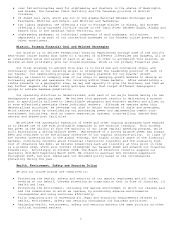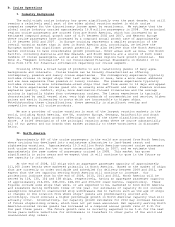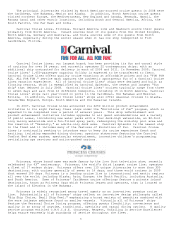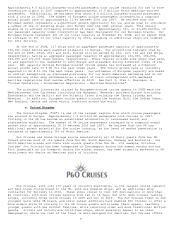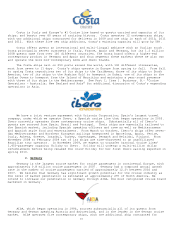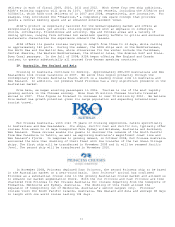Carnival Cruises 2008 Annual Report Download - page 8
Download and view the complete annual report
Please find page 8 of the 2008 Carnival Cruises annual report below. You can navigate through the pages in the report by either clicking on the pages listed below, or by using the keyword search tool below to find specific information within the annual report.
8
Approximately 4.0 million European-sourced passengers took cruise vacations for two or more
consecutive nights in 2007 compared to approximately 10.5 million North American-sourced
passengers. Additionally, we estimate that about 4.6 million European-sourced passengers
took a cruise in 2008. The number of European cruise passengers increased by a compound
annual growth rate of approximately 11.4% between 2002 and 2007. We believe that the
European market represents a significant growth opportunity for us, and we plan to introduce
a number of new or existing ships into Europe over the next several years. This should
enable us to achieve increasing economies of scale. Approximately 72%, or 27,296 berths, of
our passenger capacity under construction has been designated for our European brands. Our
European brands represent 32% of our total capacity at November 30, 2008, and we expect them
to increase to 39% of our total capacity by 2012, assuming no additional ships are ordered
for 2012 delivery.
At the end of 2008, 117 ships with an aggregate passenger capacity of approximately
130,000 lower berths were marketed primarily in Europe. Our projections indicate that by
the end of 2009, 2010, 2011 and 2012, Europe will be served by 122, 127, 130 and 133 ships,
respectively, having an aggregate passenger capacity of approximately 144,000, 156,000,
164,000 and 172,000 lower berths, respectively. These figures include some ships that were,
or are expected to be, marketed in both Europe and elsewhere during different times of the
year. Net capacity serving European-sourced cruise guests has increased at a compound
annual growth rate of 9.8% for the past three years. The future growth rate is currently
expected to be 8.1% for the next three years. Our estimates of European capacity are based
on similar assumptions as discussed previously for our North American estimates and do not
consider any older ship withdrawals as a result of their noncompliance with mandated
maritime regulations that become effective in 2010. See Part I, Item l. Business. B.-
"Cruise Operations – Governmental Regulations - Maritime Regulations".
The principal itineraries visited by European-sourced cruise guests in 2008 were the
Mediterranean, the Caribbean (including the Bahamas), Bermuda, northern Europe (including
Scandinavia and the Baltic) and the Atlantic Isles (including the Canary Islands and
Madeira). In addition, European cruise guests visited the Arabian Gulf, the Indian Ocean,
New England, Canada and other exotic locations around the world.
a. United Kingdom
The United Kingdom ("UK") is one of the largest regions from which cruise passengers
are sourced in Europe. Approximately 1.3 million UK passengers took cruises in 2007.
Cruising in the UK has become an established alternative to land-based resort and
sightseeing vacations. The number of UK cruise passengers increased by a compound annual
growth rate of approximately 10.2% between 2002 and 2007. We believe that the UK has
additional growth potential for the cruise industry, as the level of market penetration is
estimated at approximately 70% of North America.
P&O Cruises and Ocean Village source substantially all of their guests from the UK.
Cunard sources most of its guests from the UK, North America, Germany and Australia. Our
North American brands and Costa also source guests from the UK. For example, Princess
Cruises' Sea Princess has been homeported in Southampton during the summer months and has
Fort Lauderdale as its homeport during the winter season, has been primarily marketed to UK
vacationers who desire an American style of cruising.
P&O Cruises, with over 170 years of cruising experience, is the largest cruise operator
and best known cruise brand in the UK, with six premium ships, and an additional ship
contracted for delivery in 2010. These ships cruise to over 235 destinations in more than
82 countries, with most cruises ranging from two to 16 days, but with some cruises lasting
longer, including three world cruises in 2009 and two in 2010. The P&O Cruises fleet is the
youngest multi-ship UK brand, and their latest additions have enabled P&O Cruises to offer a
more modern style of cruising to its UK cruise guests and broaden their appeal, reaching
younger guests with and without families, while retaining older and more traditional British
guests. Artemis and Arcadia are child-free ships, which generally appeal to an older
demographic, while the rest of the fleet is well-equipped for families. P&O Cruises offers




